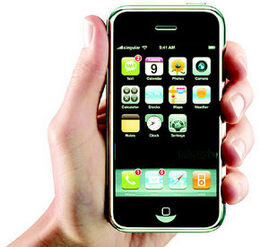hankyoreh
Links to other country sites 다른 나라 사이트 링크
iPhone sales generate mixed impact on S. Korean market

Is the ‘iPhone effect’ a double-edged sword?
After Apple Inc. began selling two models of its newly-released iPhone, related industries in South Korea have shown mixed responses. Semiconductor manufacturers are benefiting as they have signed long-term contracts to supply chips to Apple, but mobile-phone makers are not sanguine because they face a tough competitor in the U.S. handset market.
Chip makers are upbeatOn July 11, contract prices for NAND flash memory chips jumped 17.8 percent to 30.2 percent a month earlier to US$5.18 to US$6.03, the sharpest gain this year, according to Taiwan-based DRAMeXchange, Asia’s biggest e-market for the chips. Spot prices also rose by as much as 4 percent.
The NAND flash chip is a key memory chip in the iPhone and Samsung Electronics Co. and other South Korean chipmakers are major suppliers of the chip. According to U.S.-based research firm iSuppli Corporation, the iPhone consists of flash memory and a main processor by Samsung Electronics, rechargeable battery by Samsung SDI Co., condenser by Samsung Electro-Mechanics Co., and a chip varistor by Amotech Co. Costs of goods manufactured for an 8-gigabyte iPhone are valued at US$266. South Korean parts account for 30.5 percent of the cost. In the first week of iPhone’s launch, Apple sold some 700,000 units, two times higher than expected. By the end of next year, Apple aims to sell 12 million iPhones.
Dongbu Securities analyst Lee Min-hee said, “When looking at chip demand for iPhones, it’s still minimal. The demand is expected to increase, however, as other mobile phone makers are introducing models to compete with iPhones. The demand for high-capacity flash memory chips will also continue to rise,” Lee said.
Uphill battle for handset makersApple reportedly planned to introduce a low-price model of iPhone to target the segment of the market with handsets priced less than US$100. Such cheaper handsets are used by more than 80 percent of American consumers. Prices of iPhone, which combines a mobile phone, media player and wireless Internet device, are currently ranging from US$499 to US$599.
South Korean handset manufacturers are drawing up countermeasures. In March, Samsung Electronics introduced its new Upstage model, which combines a cell phone and a digital music player. Samsung also plans to sell its touch screen-based Smartphone F700 this autumn. LG Electronics Inc. is preparing to sell a revamped model of its Chocolate phone with more music functions. LG is also considering selling its touch screen-based Prada phone to the U.S. market. A Samsung Electronics executive expressed confidence in competing with Apple, saying “The sales target of iPhone is only 1 percent of the global mobile phone market.”
In the U.S. market last year, Samsung sold 12 million handsets based on a European technology standard, while LG sold 5.2 million such mobile phones.
Please direct questions or comments to [englishhani@hani.co.kr]
Editorial・opinion
![[Guest essay] The real reason Korea’s new right wants to dub Rhee a founding father [Guest essay] The real reason Korea’s new right wants to dub Rhee a founding father](https://flexible.img.hani.co.kr/flexible/normal/500/300/imgdb/original/2024/0423/8317138574257878.jpg) [Guest essay] The real reason Korea’s new right wants to dub Rhee a founding father
[Guest essay] The real reason Korea’s new right wants to dub Rhee a founding father![[Column] ‘Choson’: Is it time we start referring to N. Korea in its own terms? [Column] ‘Choson’: Is it time we start referring to N. Korea in its own terms?](https://flexible.img.hani.co.kr/flexible/normal/500/300/imgdb/original/2024/0423/3617138579390322.jpg) [Column] ‘Choson’: Is it time we start referring to N. Korea in its own terms?
[Column] ‘Choson’: Is it time we start referring to N. Korea in its own terms?- [Editorial] Japan’s rewriting of history with Korea has gone too far
- [Column] The president’s questionable capacity for dialogue
- [Column] Are chaebol firms just pizza pies for families to divvy up as they please?
- [Column] Has Korea, too, crossed the Rubicon on China?
- [Correspondent’s column] In Japan’s alliance with US, echoes of its past alliances with UK
- [Editorial] Does Yoon think the Korean public is wrong?
- [Editorial] As it bolsters its alliance with US, Japan must be accountable for past
- [Guest essay] Amending the Constitution is Yoon’s key to leaving office in public’s good graces
Most viewed articles
- 1[Column] ‘Choson’: Is it time we start referring to N. Korea in its own terms?
- 2Why Korea shouldn’t welcome Japan’s newly beefed up defense cooperation with US
- 3Senior doctors cut hours, prepare to resign as government refuses to scrap medical reform plan
- 4[Guest essay] The real reason Korea’s new right wants to dub Rhee a founding father
- 5Opposition calls Yoon’s chief of staff appointment a ‘slap in the face’
- 6[Column] The clock is ticking for Korea’s first lady
- 7Terry Anderson, AP reporter who informed world of massacre in Gwangju, dies at 76
- 8New AI-based translation tools make their way into everyday life in Korea
- 9Samsung barricades office as unionized workers strike for better conditions
- 10Korea ranks among 10 countries going backward on coal power, report shows